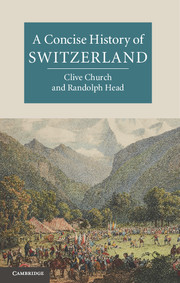Book contents
- Frontmatter
- Contents
- List of Illustrations
- List of Figures
- List of Maps
- Acknowledgements
- List of Abbreviations
- Introduction Making the Swiss
- 1 Before Switzerland
- 2 Creating the Swiss Confederacy, 1386–1520
- 3 A divided Switzerland in Reformation Europe, 1515–1713
- 4 The Ancien Régime, 1713–1798
- 5 Revolution and contention, 1798–1848
- 6 Forging the new nation, 1848–1914
- 7 The shocks of war, 1914–1950
- 8 The Sonderfall years, 1950–1990
- 9 Since 1989
- Chronology
- Glossary
- Further Reading
- Index
8 - The Sonderfall years, 1950–1990
Published online by Cambridge University Press: 05 June 2013
- Frontmatter
- Contents
- List of Illustrations
- List of Figures
- List of Maps
- Acknowledgements
- List of Abbreviations
- Introduction Making the Swiss
- 1 Before Switzerland
- 2 Creating the Swiss Confederacy, 1386–1520
- 3 A divided Switzerland in Reformation Europe, 1515–1713
- 4 The Ancien Régime, 1713–1798
- 5 Revolution and contention, 1798–1848
- 6 Forging the new nation, 1848–1914
- 7 The shocks of war, 1914–1950
- 8 The Sonderfall years, 1950–1990
- 9 Since 1989
- Chronology
- Glossary
- Further Reading
- Index
Summary
If the Swiss had found themselves under a cloud immediately after 1945, they were soon able to compensate, thanks to the way history speeded up thereafter. In fact the post-war years saw probably the greatest and most rapid economic and social changes Switzerland has ever undergone. This, on top of their efforts in the war, led many Swiss, and some foreigners, to think of Switzerland as the ‘Sonderfall Schweiz’, as an exceptional country: more prosperous, more harmonious, more democratic, more self reliant, more able to solve its problems and more moral than most other states. Switzerland’s exceptionalism was attributed to distinctive institutions like neutrality, federalism and direct democracy, and also to the way the Swiss coped with their social, religious and linguistic diversities within a nation-state, leading one foreign authority to call the country a ‘paradigm of integration’. In other words, the Swiss felt themselves, along with a benign Providence, to be the main authors of their own success.
They could point to the fact that, within thirty years of the end of the war, Switzerland had become a very rich country. It had also carved out a successful new international role for itself and had been able to overcome a series of challenges from linguistic division, a renewed anti-foreigner right, environmentalism and the post-1968 new left. These challenged both the direction Switzerland was taking and the new self-image behind Swiss confidence. Such challenges, however, like the recessions of the 1970s, were at first overcome, even as the country drifted once more to the right. However, by the late 1980s, fissures were beginning to appear in the Sonderfall, with arguments over the UN, Green issues and state security posing challenges that ultimately upset the complacency behind the whole Sonderfall model.
- Type
- Chapter
- Information
- A Concise History of Switzerland , pp. 227 - 253Publisher: Cambridge University PressPrint publication year: 2013



